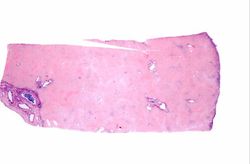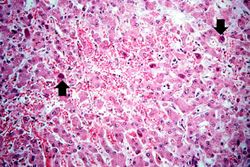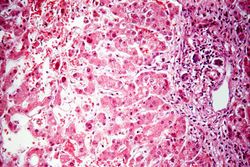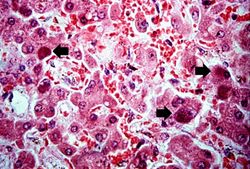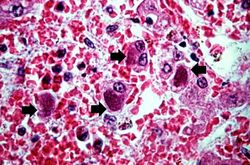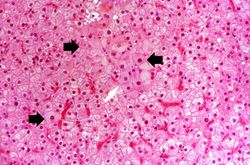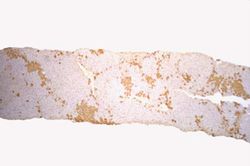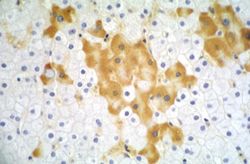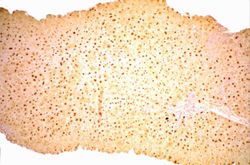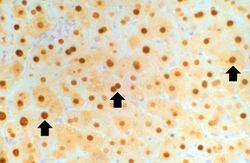Difference between revisions of "IPLab:Lab 8:Hepatitis B"
Seung Park (talk | contribs) |
|||
| Line 20: | Line 20: | ||
File:IPLab8HBV10.jpg|This high-power photomicrograph of the previous section shows the HBcAg positive nuclei (arrows). | File:IPLab8HBV10.jpg|This high-power photomicrograph of the previous section shows the HBcAg positive nuclei (arrows). | ||
</gallery> | </gallery> | ||
| + | |||
| + | == Study Questions == | ||
| + | * <spoiler text="What sorts of clinical/pathologic syndromes can occur after infection with HBV?">HBV can produce: | ||
| + | # acute hepatitis, | ||
| + | # chronic nonprogressive hepatitis, | ||
| + | # progressive chronic disease ending in cirrhosis, | ||
| + | # fulminant hepatitis with massive liver necrosis, and | ||
| + | # an asymptomatic carrier state with or without progressive disease.</spoiler> | ||
| + | * <spoiler text="What is the association between HBV and hepatocellular carcinoma?">There is a strong association between HBV infection and the occurrence of liver cancer (hepatocellular carcinoma). In Taiwan, HBV infected people have a greater than 200-fold increased risk of developing liver cancer as compared with uninfected individuals. However, the precise role of HBV in the causation of human liver cancer is not clear.</spoiler> | ||
| + | * <spoiler text="What are the characteristics of the hepatitis B 'carrier state'?">With hepatotropic viruses, there are those who: | ||
| + | # harbor one of the viruses but suffer little or no adverse effects (a "healthy" carrier) and those who | ||
| + | # have chronic disease but are essentially free of symptoms or disability. | ||
| + | Both constitute reservoirs of infection. HBV infection early in life, particularly via vertical transmission during childbirth, produces a carrier state 90 to 95% of the time. In contrast, only 1 to 10% of adult infections yield a carrier state. Individuals with impaired immunity are more likely to become carriers.</spoiler> | ||
{{IPLab 8}} | {{IPLab 8}} | ||
[[Category: IPLab:Lab 8]] | [[Category: IPLab:Lab 8]] | ||
Revision as of 15:51, 21 August 2013
Clinical Summary[edit]
This was a 55-year-old white male with chronic renal failure who acquired hepatitis B virus (HBV) in a renal dialysis unit. Death was the result of multiple disease processes, which included active pulmonary tuberculosis and heart failure due to ischemic heart disease. There were few or no symptoms or signs of hepatitis during life other than seroconversion from negative to HBsAg positive.
Autopsy Findings[edit]
At autopsy, the liver was enlarged due primarily to severe passive congestion.
Images[edit]
This is a low-power photomicrograph of liver from this case. This section was stained with a modified aldehyde fuchsin and counterstained with hematoxylin and eosin. Modified aldehyde fuchsin colors cystine-rich proteins--such as HBsAg and elastic fibers--deep purple. The cytoplasm of most liver cells (and RBCs) stain red due to the eosin and have dark blue nuclei.
Study Questions[edit]
| |||||
Renal failure is the severe reduction of renal function and often leads to reduced urinary output.
Cirrhosis is a liver disease characterized by necrosis, fibrosis, loss of normal liver architecture, and hyperplastic nodules.
The normal fibrinogen level is 184 to 412 mg/dL.
